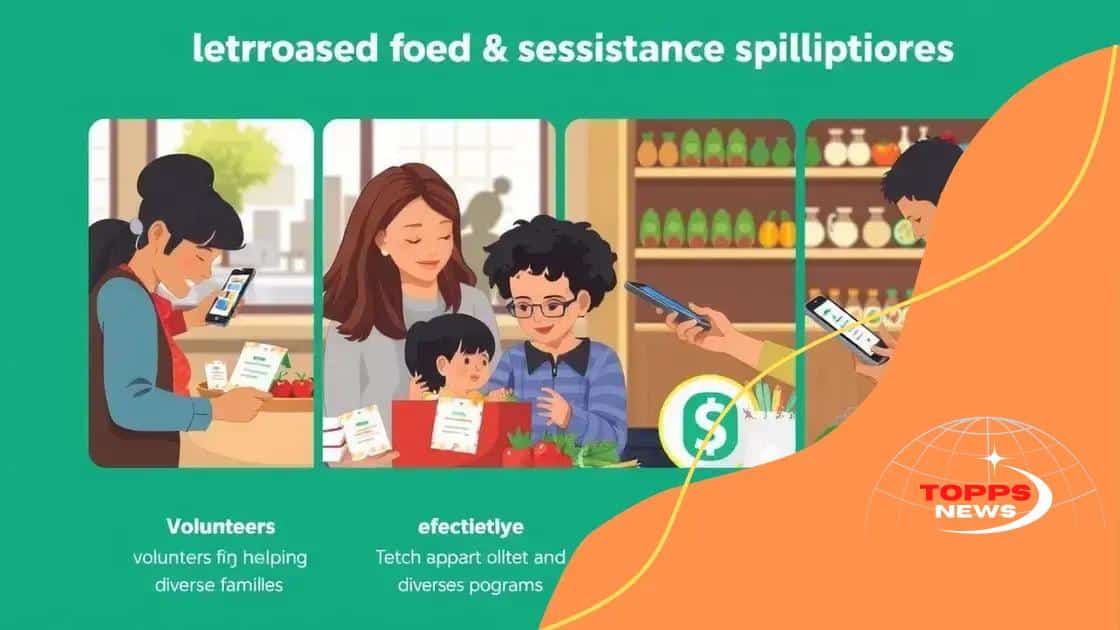Food assistance program modernization: a new era of support

Food assistance program modernization improves efficiency, accessibility, and community collaboration while focusing on nutrition education to better support individuals facing food insecurity.
Food assistance program modernization is changing the way we approach hunger relief. With evolving needs and technologies, it’s vital to consider how these updates can improve accessibility and effectiveness. Ready to learn more about the future of food assistance?
Overview of food assistance programs
Understanding food assistance programs is essential for recognizing how they help individuals and families in need. These programs provide vital resources to combat hunger and improve nutrition.
Types of Food Assistance Programs
There are several key programs designed to help those facing food insecurity:
- Supplemental Nutrition Assistance Program (SNAP)
- Women, Infants, and Children (WIC)
- National School Lunch Program (NSLP)
- Emergency Food Assistance Program (TEFAP)
Each of these programs targets different populations, ensuring that food relief reaches a diverse group. For instance, SNAP offers benefits to households based on income, while WIC supports pregnant women and young children with specific nutritional needs.
The Goals of Food Assistance
The primary aim of food assistance programs is to alleviate hunger and improve overall health. Moreover, these initiatives strive to provide:
- Access to nutritious food
- Education on healthy eating
- Support for local food systems
By meeting these goals, food assistance programs help ensure that individuals can lead healthier lives, promoting stronger communities.
In summary, understanding the landscape of food assistance programs is crucial for seeing how they mitigate hunger and enhance well-being among vulnerable populations. Each program plays a vital role in addressing food insecurity and supporting those in need.
The need for modernization
The need for modernization in food assistance programs is becoming increasingly clear. As society evolves, so do the challenges related to hunger and food access.
Changing Demographics
One major reason to modernize is the shifting demographics of those in need. More families are experiencing food insecurity, including working-class households. It’s essential for programs to adapt to serve diverse populations better.
- Single-parent families
- Low-income individuals
- Senior citizens
- Students in need
By addressing these changes, assistance programs can become more effective and inclusive.
Advances in Technology
Technology has also advanced rapidly. There are tools available that can streamline the distribution of food aid, making it more accessible. For example, mobile applications can help users locate nearby food pantries or apply for benefits easily. With the use of technology, programs can reach more people quickly.
Moreover, data analysis can improve how resources are allocated based on real-time needs, ensuring that assistance gets to those who require it most. Modernization helps optimize resources and enhance efficiency.
Continuing this push for modernization will lead not only to improved outcomes for those in need but also to stronger community ties. Connecting neighborhoods with adequate services benefits everyone and fosters a sense of belonging.
Key benefits of modernization

Modernizing food assistance programs brings a host of key benefits that can significantly enhance their effectiveness. It allows for better resource management and improved access to support for those in need.
Increased Efficiency
One major advantage of modernization is increased efficiency. By adopting new technologies, food assistance programs can streamline processes.
- Faster application processing
- Improved data management
- Quicker distribution of food and resources
This efficiency reduces wait times for individuals seeking help, allowing them to receive assistance when they need it most.
Enhanced Accessibility
Modernization also enhances accessibility. With online applications and mobile platforms, individuals can apply for benefits from anywhere. This is especially important for those who may have transportation issues or live in remote areas. Flexibility in applying ensures that more people can access the help they deserve.
Furthermore, these programs can utilize community partnerships to broaden their reach, engaging local organizations and resources.
Better Nutrition through Targeted Programs
Another benefit is the potential for improved nutrition. By utilizing data analytics, programs can identify the specific needs of communities. This helps tailor food offerings to better meet the dietary requirements of diverse populations. It also allows for:
- More nutritional education
- Focus on fresh and healthy foods
- Customizable meal options based on cultural preferences
As a result, participants are more likely to consume healthier diets, leading to improved overall health outcomes.
Challenges faced in implementing changes
Implementing changes in food assistance programs is not without its challenges. While modernization can provide many benefits, various obstacles must be addressed to ensure success.
Funding Limitations
One significant challenge is the funding limitations. Many food assistance programs rely heavily on government funding, which can fluctuate based on budget priorities. This can hinder the ability to adopt new technologies or expand services.
- Inconsistent financial support
- Competing budget demands
- Need for sustainable funding models
Without adequate funding, it can be difficult to make the necessary changes that can improve efficiency and access.
Resistance to Change
Another challenge is the resistance from stakeholders. This may include individuals working within the programs or community partners. Changing established practices can lead to uncertainty and apprehension about new methods.
Building trust and support is crucial for overcoming this resistance. Education and clear communication about the benefits of modernization can help alleviate concerns.
Technological Barriers
Technological barriers also pose significant issues. Not all organizations have the same level of access to technology or resources. In some cases, staff training is necessary to utilize new tools effectively. Common barriers include:
- Lack of infrastructure
- Insufficient training for staff
- Difficulty integrating new systems with existing ones
Addressing these barriers requires investment in training and support to ensure all stakeholders feel confident in using new technologies.
Future outlook for food assistance programs
The future outlook for food assistance programs is promising as communities and organizations recognize the need for change. Adapting to new technologies and strategies will enhance the support provided to those in need.
Integration of Technology
Future programs will likely continue integrating technology. Digital tools help streamline processes and make resources more accessible. For instance, mobile apps can improve communication between food banks and clients.
- Real-time tracking of food inventory
- Online applications for assistance
- Text message alerts for available resources
These innovations can lead to a more efficient distribution of aid, helping more people in less time.
Community Collaboration
Another trend is increased community collaboration. Food assistance programs are beginning to partner with local organizations, schools, and businesses. These collaborations enhance resource sharing and create comprehensive support networks.
Working together, communities can tackle food insecurity more effectively, ensuring that no one is left behind. This approach allows for:
- More localized solutions
- Better outreach to underserved populations
- Stronger community ties
By harnessing community support, food assistance programs can adapt to the specific needs of their populations.
Emphasis on Nutrition Education
The future will also see a greater emphasis on nutrition education. Programs are expected to focus not just on providing food, but also on teaching clients how to make healthier choices. Informative workshops and cooking classes can empower individuals to improve their diets.
As awareness grows about nutrition’s role in health, food assistance programs can play a vital part in fostering healthier communities.
FAQ – Frequently Asked Questions about Food Assistance Program Modernization
What are the main benefits of modernizing food assistance programs?
Modernizing food assistance programs increases efficiency, enhances accessibility, promotes community collaboration, and emphasizes nutrition education.
How can technology improve food assistance programs?
Technology can streamline application processes, enable real-time tracking of resources, and facilitate communication between organizations and clients.
What challenges do food assistance programs face during modernization?
Challenges include funding limitations, resistance to change from stakeholders, and technological barriers that impact implementation.
Why is community collaboration important in food assistance?
Community collaboration helps leverage local resources, enhances outreach to those in need, and creates a more support-focused network for individuals facing food insecurity.





